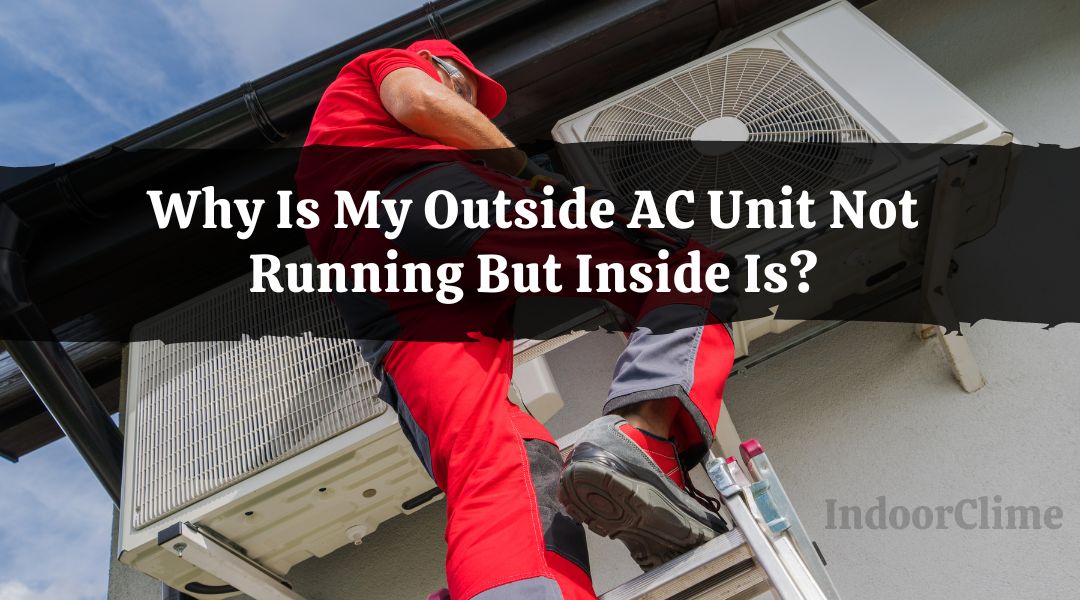Homes in hot places like California and Florida usually require a cooling system to maintain a comfortable indoor temperature. A split-type air conditioner is ideal for many because of its convenience and efficiency. But if your outside unit is operating, but the inside is, read on.
If your split-type air conditioner’s outside unit is running, but the inside isn’t, there’s a good chance of a circuit breaker issue, damaged wires, defective parts, and a lousy capacitor, to name a few.
A split-type air conditioner comes in two parts, an outdoor unit and an indoor unit connected by refrigerant lines. The outdoor unit contains a compressor, while the indoor unit is usually in a closet or attic. In this article, we’ll help you identify problems when the inside unit is not running and solutions to solve this issue.
How To Know That Outside AC Unit Is Not Running?
You can check a few things to know if your outside AC unit is running.
First, check if the breaker is switched on. The breaker usually controls the inside and outside units, so turn it on. If it’s turned off, turn it back on and wait for the AC to cool your home.
Check the wires connecting the two units if the breaker is on, but the inside unit isn’t working. If any of these wires are damaged or disconnected, it could be why your air conditioner isn’t working.
Try to reconnect any loose wire and see if that does the trick. However, only do this when you have some technical expertise to avoid further damage.
Check the capacitor. The capacitor starts the outside unit by giving it an electrical charge. If it’s defective, it could be why your unit isn’t working. Try to check if the capacitor is bulging or leaking, which shows that it needs to be replaced.
Last, check for any particles or debris blocking the condenser coils. The coils are located in the outdoor unit and help release heat from the refrigerant. If these coils are clogged, it could prevent the AC from cooling your home correctly.
Inside AC is Working, But Outside AC is Not: Reasons Why?

There are several factors affecting the operation of your air conditioning system.
1. Circuit Breaker Issues
The circuit breaker usually controls both the inside and outside units. If it’s turned off, turn it back on and wait for the air conditioner to cool your home.
2. Damaged Wires
Check the wires connecting the two units if the breaker is on, but the inside unit isn’t working. If any of these wires are damaged or disconnected, try to reconnect any loose wire and see if that does the trick.
However, ensure you have the basic technical skills and know-how before attempting to solve this issue.
3. Defective Parts
Over time, parts of your unit will wear out and break. This is especially true for the compressor.
The entire AC system will not work if the compressor is not working.
4. Bad Capacitor
The capacitor helps start the compressor when the AC is first turned on. If this part is faulty, the compressor will not start, and the unit will not work.
5. Low Refrigerant Levels
If the refrigerant levels are low, it will prevent the air conditioner from cooling your home correctly, and this is because the refrigerant is what carries the heat away from your home.
6. Dirty Condenser Coils
The condenser coils are located in the outdoor unit and help release heat from the refrigerant. If these coils are blocked, it could prevent the system from maintaining a cool temperature.
7. Clogged Drain Line
The drain line helps remove water created by the system. If this line is clogged, it can cause water to build up and damage the AC unit.
How To Fix This?
You can try a few things to fix this issue on your own.
Check the Circuit Breaker
The first thing you should do is check the circuit breaker. The breaker usually controls the inside and outside units, so turn it on.
If it’s turned off, turn it back on and wait for the AC to cool your home.
Assess For Faulty Wires
Look for any visible cuts or damage to the wires. Do not turn on your unit if you see a damaged wire, and doing this may cause further damage or even cause an electric shock.
Ask an HVAC technician to assess the situation, and don’t attempt to rewire if you don’t have the proper expertise.
Evaluate the Capacitor’s Efficiency
The capacitor helps start the compressor when the unit is first turned on. If this part is faulty, the compressor will not start, and the AC will not work.
You can test whether the capacitor is working by using a multimeter.
Clean the Condenser Coils
The condenser coils are responsible for releasing heat from the refrigerant. If these coils are blocked, it could prevent the AC from cooling your home properly.
You can clean the coils using a brush or vacuum to remove debris.
Make Sure There Are No Leaks In the System
Any leaks in the system could cause the refrigerant levels to drop, preventing the AC from cooling your home correctly.
Try to find and fix any visible leaks with duct tape or a sealant before calling a reliable technician to evaluate the problem.
Call a Professional
A professional HVAC technician should check more technical aspects of your unit. It’s essential to turn off the unit and check it with a skilled professional to avoid further damage.
They can diagnose the problem and find the best solution properly.





